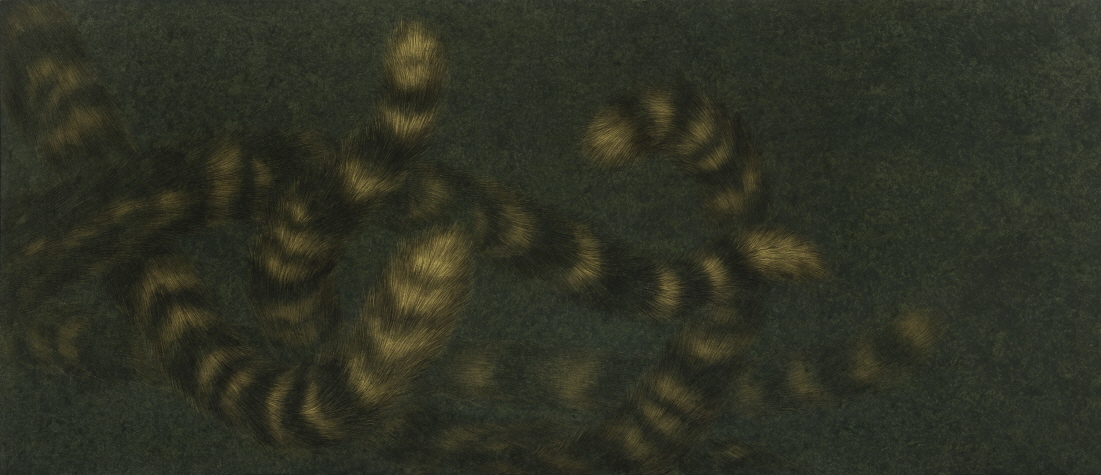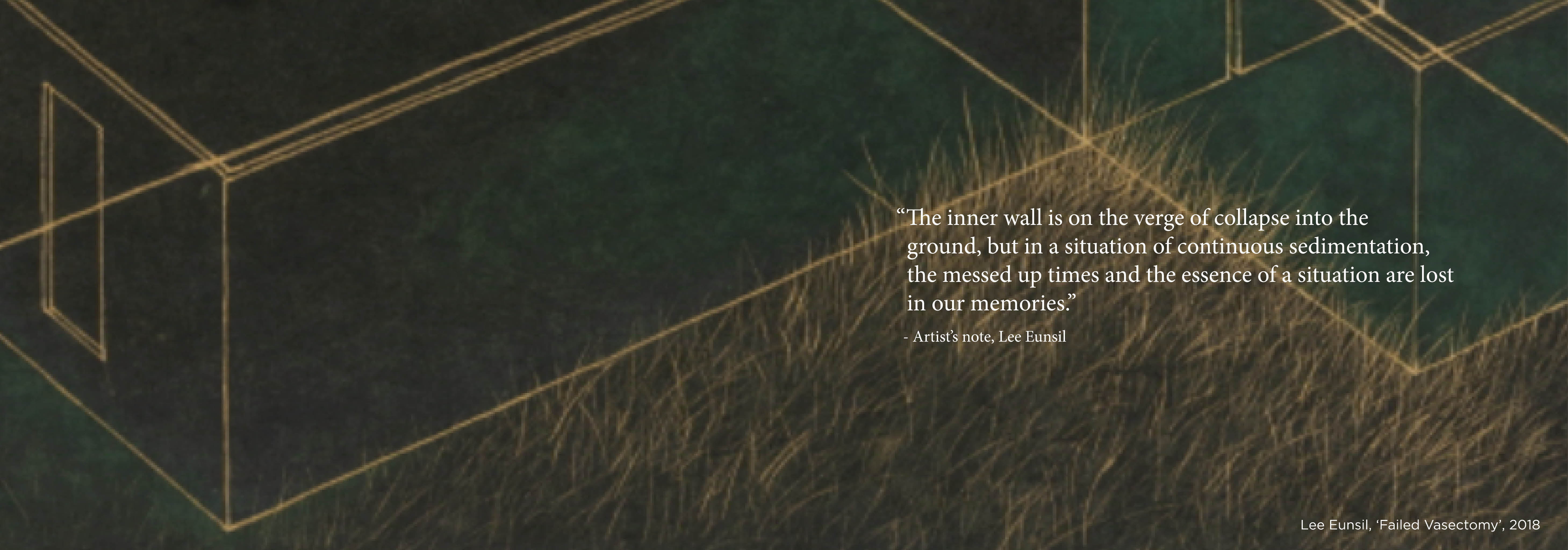 Lee Eunsil, 'Tangle,' 2019, Colors and ink on Korean paper, 59.7 × 136 cm.
Lee Eunsil, 'Tangle,' 2019, Colors and ink on Korean paper, 59.7 × 136 cm.Lee Eunsil’s (b. 1983) artworks are very traditional in terms of technique and materials. Her works resemble a typical traditional Korean painting in which the artist treats thickly layered Hanji paper with glued water so that it can absorb thin but repeated brushstrokes.
However, upon closer inspection, Lee’s works are nothing like those old paintings. The described landscapes are dark and damp. Even more ominous is the impression created by the dim, subdued scenes in the paintings.
These works might often make people cringe with embarrassment since they depict a rather provocative scene. The golden furs of the copulating tigers contrast with the dark greenish, damp night landscape. Male and female figures are depicted with their genitals exposed, and various shapes and objects, such as tiger tails, stone pillars, and terrain, allude to the genitalia. Even the architectural structures adapted from traditional Korean buildings give the viewer the impression that they are peering into those happenings.
 Lee Eunsil, 'BIONIC PENIS, PRESS THE BUTTON!,' 2019, Colors and ink on Korean paper, 245 × 540 cm
Lee Eunsil, 'BIONIC PENIS, PRESS THE BUTTON!,' 2019, Colors and ink on Korean paper, 245 × 540 cmThe artist uses motifs of tigers, architectural structures, and natural objects to metaphorically express the conflict between human instinct and civilization. The artist visualizes socially unacceptable behaviors, attitudes, and forms derived from primitive impulses, repressed emotions, and internal conflicts. The paintings are more explicit and bald than obscene.
All humans possess primitive instincts and desires, but we also consider social realities and norms, etiquette, and rules. But repressed and unfulfilled desires sometimes appear to us as uncanny and fragmented expressions. The artist expresses this psychological process through the use of three important elements: sex, space, and mental division.

Lee Eunsil, 'The inside of ⌜Into the hole⌟,' 2009, Colors and ink on Korean paper, 225 × 170 cm
Since Lee’s earliest works, sex has been a recurring theme, reflecting the sexual and gender roles shaped in our society. Desire (2005) features a tiger and a deer. The described scene hints that the two have finished intercourse. The tiger, with its red genitals still erected, seems to be leaving the place while the bleeding doe is gazing at the tiger. The painting depicts the complicated psychological drama that happened between the two characters. In the work titled In the Night (2017), two beings resembling human-like monsters covered in fur are in the midst of sexual intercourse, showing a scene that we shouldn’t watch.

Lee Eunsil, 'Packed,' 2019, Colors and ink on Korean paper, 160 × 46 cm
The architectural structure of a hanok, a traditional Korean house, serves to separate the scenes and direct the eye. These structures serve as a barrier between the interior and exterior. An interior is a comfortable place. It can be a wall covering the secret and private actions of others, but it also creates a borderline that prevents us from seeing the outside world. The window attached to the structure serves as a passage through which one can see the inside from the outside, connecting the free but dangerous outside world with the confined but comfortable inside world. It can also become a device that induces the viewer to engage in a taboo act, as if secretly spying on what is happening inside.
Lee’s recent works are more abstract and metaphorical than her previous works, as she focuses more on mental anxiety and tension. Genitals and body organs are still depicted in the paintings, but they appear to have moved to a different dimension. In Lee’s depiction of herself, the ego eventually breaks in the process of collision between the social frame and the primal instinct. Lee expresses this as scattered, disassembled, floating structures and body parts that are distorted, divided and overlapped.

Artist Lee Eunsil. Courtesy of the artist.
Lee Eunsil (b. 1983) has held solo exhibitions at various art institutions and galleries, such as P21 (2021, Seoul), UArtSpace (2019, Seoul), Doosan Gallery (2016, New York), Project Space Sarubia (2010, Seoul), and Alternative Space Pool (2009, Seoul), as well as group exhibitions held at the Coreana Museum of Art (2020, Seoul) and SongEun Art Space (2019, Seoul).
In 2019, she received the Excellence Award at the 19th SongEun Art Awards and participated in ArtSpectrum 2014, held at the Leeum Museum of Art in 2014. Lee also participated in the 2020 SongEun Art Studio, the 2018 Incheon Art Platform Residency, and the 2016 Doosan Art Center Residency Program.


















